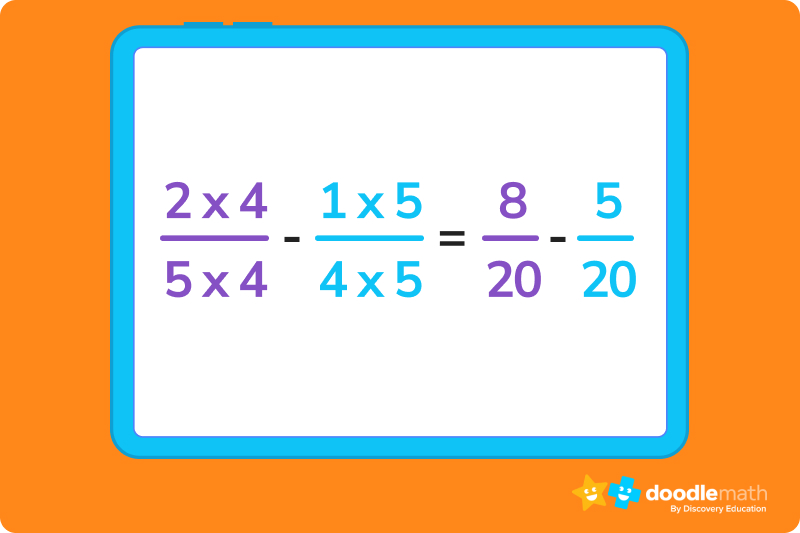Don’t fear fractions– embrace them! Learn how adding and subtracting fractions can help in real world situations.

Author
Taylor Hartley

Expert Reviewer
Jill Padfield
Published: January 18, 2024


Don’t fear fractions– embrace them! Learn how adding and subtracting fractions can help in real world situations.

Author
Taylor Hartley

Expert Reviewer
Jill Padfield
Published: January 18, 2024




Don’t fear fractions– embrace them! Learn how adding and subtracting fractions can help in real world situations.

Author
Taylor Hartley

Expert Reviewer
Jill Padfield
Published: January 18, 2024


Key takeaways
Have a fear of fractions? While they can be a bit tricky, learning how to add and subtract fractions is an important skill to master, and it has a ton of real world applications.
Once you master this skill, you can move on to the next level of complex maths concepts, such as multiplying and dividing fractions. Let’s dig in to learn more adding and subtracting fractions, and you’ll be ready in no time!
Simply put, fractions are numbers in between whole numbers. The best way to visualise this is to look at a ruler. Consider the small markings in between 0 and 1. Each marking represents a number, different than a whole number, between 0 and 1. These are called fractions!
Fractions help us be more accurate with amounts and measurements. For example, if you need a piece of wood that’s 1 3/4 long, you can use a ruler to make a mark at 1 3/4 before you cut it.
To write a fraction, it’s important to first know about numerators and denominators. The numerator is always the number on top, and the denominator is always the number at the bottom. Here’s a simple example:
Unlock unlimited maths questions
Put your learning into practice with fun exercises + games that are proven to boost ability!

Before moving on, remind yourself how to identify basic fractions with this handy video! Check out our other topic walkthroughs for even more maths guides.
There are three common types of fractions, including:
When adding and subtracting fractions, the most common types of fractions used are like and unlike fractions and equivalent fractions. Let’s take a look at each!
Like fractions are fractions with the same denominators — and this is super easy to remember because “like” means “the same” or “similar.” For example, 1/4 and 3/4 are like fractions because they have the same denominator: 4. The 4s in this example are “alike.”
Unlike fractions are fractions with different denominators. Again, an easy way to remember this is to think of the denominators as “different” or “not alike.” For example, 1/3 and 3/4 are unlike fractions because they have different denominators: 3 and 4, respectively.
Fractions that have different numerators and denominators, but are equal to the same value when simplified, are called equivalent fractions. Let’s look at an example of a handful of different fractions that all represent a half — this will be an easy way to remember equivalent fractions!
All fractions in this list represent 1/2 or half, meaning they’re all equivalent fractions:

Before we jump into some examples and steps to adding and subtracting fractions, let’s cover some basic terms that you will come across.
Sometimes, fractions can be intimidating! The best place to start is to familiarise yourself with the concept of fractions and why they’re important in the real world.
Let’s picture a pizza that’s cut into 6 slices. You want one piece of pizza, so your portion can be expressed as 1/6 of the pizza. Your friend is hungry and eats 2 pieces of pizza. Their portion can be expressed as 2/6 of the pizza. Now, you’re trying to figure out how much pizza you and your friend have eaten total.
You know that you had 1/6 and your friend had 2/6. Since you’re both eating from the same 6-cut pizza, the denominator is the same, and you simply have to add your portion (1) to your friend’s portion (2) to see how much of the pizza has been eaten: 1 + 2 = 3. You and your friend have eaten 3/6 of the pizza.
In this example, the above problem would be written as:

DoodleMaths is an award-winning maths app that’s filled with games and questions covering the EYFS, KS1 and KS2 curriculum!
Created by teachers, it automatically targets tricky topics and tops up each child’s knowledge, helping them get ahead in their learning. Why not try it for free today?


Similar to how we can add and subtract whole numbers, we can add and subtract fractions. First, remember the different types of fractions: like, unlike, and equivalent. One important rule: we can only add and subtract like fractions.
The reason is simple — you cannot add 2 bananas and 3 apples to get 5 bananas because they are not all bananas. It’s the same way with fractions: you can’t add unlike fractions because they have different “denominators” or unit quantities. The same goes for subtraction. You cannot subtract unlike units from one another.
Let’s go through the steps of adding and subtracting fractions together!
If you’re working with like fractions (such as 1/3 and 2/3), the denominators will already be the same, so you can move to step 2. However, when you’re faced with two fractions with unlike denominators, you will have to make the fractions like fractions. There are two ways you may have to approach this.
A. If one denominator is a multiple of the other denominator….
Let’s use the following example:

In this example, the denominators are different: 4 and 8. However, 8 is a multiple of 4. This means we can multiply 4 x 2 to make it 8. By doing this, the denominators are the same, which makes them like fractions. But, we can’t stop there! 2/8 is not be an equivalent fraction to 2/4 — leaving it as 2/8 makes it an entirely different fraction.
So, we have to also multiply the numerator (2) by the same number we multiplied the denominator by (2). This changes 2/4 to be 4/8. 2/4 and 4/8 are equivalent fractions, and 4/8 and 3/8 are like fractions, so now we are able to add the fractions. The problem now looks like this:

B. If both the denominators have no common factor….
Let’s use this problem as an example:

The denominators are different: 5 and 4. Also, 4 is not a multiple of 5, and 5 is not a multiple of 4. The easiest thing to do here is to multiply both denominators together to find a common factor. So: 5 x 4 = 20. 20 then becomes our new denominator for both fractions.
Remember, you also have to multiply the numerators to convert each equation into an equivalent fraction to keep the equation the same. Here’s how we would do that:

Once you have like fractions, you are able to add and subtract the numerators. The sum or difference will become the new numerator, while the common denominator discussed in step 1 will remain the same.
Here’s Step 2 from our two examples above — an example of each:
A. 4/8 + 3/8 = ⅞

B. 8/20 – 5/20 = 3/20

Sometimes our answers can be simplified into equivalent fractions that use the greatest common divisor. Both of our examples are in their most simplified form, but let’s consider the following example:

When we subtract 3/20 from 5/20, the result is 2/20, which is the correct answer. However, it can be simplified because the numerator and denominator have a common factor: 2. We can always simplify fractions until there are no common factors left between the numerator and denominator other than 1.
Let’s practise by simplifying, or reducing, the fraction 2/20.
2 is a common factor in both the numerator and the denominator, so it can be reduced to its simplified form as follows:

2 goes into 20 ten times.
We know that 5 and 6 do not share any common factors, so we must multiply 5 x 6 to find the common denominator. The common denominator of 1/5 and 4/6 is 30.
First, we have to make the denominators the same. The original denominators are 3 and 9. 9 is a multiple of 3, so the common denominator is 9.

Then, we can rewrite the problem as 6/9 + 1/9, and add the numerators. Then, we have 7/9. This fraction cannot be simplified, so the final answer is 7/9.
First, we have to make the denominators the same. The common denominator will be 8 x 7 = 56.
Now, let’s make each fraction an equivalent fraction.

Then, we can subtract the numerators. So, 21 – 8 = 13. Now, we can write our result as 13/56. This fraction cannot be simplified, so the final answer is 13/56.
Ready to give it a go?
Now that we know about the different types of fractions, how to find the common denominator, and how to add and subtract fractions, we’re ready to do a few more practice problems to put our new skills to the test! Work through the following problems on your own. Feel free to look back at the practice problems above if you get stuck or if you need a quick reminder on how to add and subtract fractions.
And remember, don’t get discouraged if you run into a roadblock! Practice is the best way to learn something new.
Click to reveal the answer.
The sum is 23/20.
The result is 1/15.
The common denominator is 10.
The equivalent fractions would be 5/10 and 2/10.
The simplified fraction is 1/3.
The sum is 23/20.
How did we get here?
The result is 1/15.
How did we get here?
The common denominator is 10.
How did we get here?
The equivalent fractions would be 5/10 and 2/10.
How did we get here?
The simplified fraction is 1/3.
How did we get here?
Sign up for the DoodleMaths app today!
Turn maths into an adventure when you sign up for DoodleMaths.
Fractions are a way of representing a part of a whole or a division of a quantity. They are used to express numbers that are not typically whole numbers, but, rather, they represent a portion or a ratio of a whole. A fraction consists of two numbers separated by a slash (“/”) or a horizontal line. The number above the line is called the numerator, and it represents the part or quantity being considered. The number below the line is called the denominator, and it represents the total number of equal parts into which the whole is divided.
The rule for adding and subtracting fractions involves finding a common denominator and then performing the operation based on that denominator. Here are the step-by-step instructions:

How to multiply fractions
Take your learning further by exploring how to multiply fractions
How to improve at mental maths
Learn some handy mental maths strategies that’ll make addition a breeze!
Lesson credits

Taylor Hartley
Taylor Hartley is an author and an English teacher based in Charlotte, North Carolina. When she's not writing, you can find her on the rowing machine or lost in a good novel.

Jill Padfield
Jill Padfield has 7 years of experience teaching mathematics. She is currently working as a Business Analyst, working to improve services for Veterans while earning a masters degree in business administration.

Taylor Hartley
Taylor Hartley is an author and teacher based in United States. When she's not writing, you can find her on the rowing machine or lost in a good novel.

Jill Padfield
Jill Padfield has 7 years of experience teaching mathematics. She is currently working as a Business Analyst, working to improve services for Veterans while earning a masters degree in business administration.
Book a chat with our team
If you’d like to use Doodle’s browser version, please visit this page on a desktop.
To log in to Doodle on this device, you can do so through our apps. You can find out how to download them here: